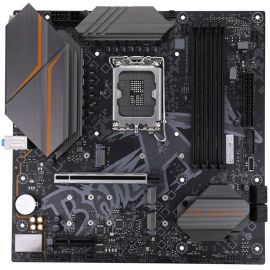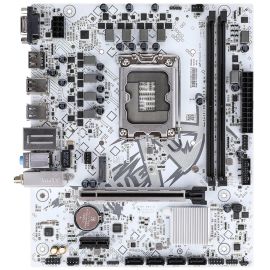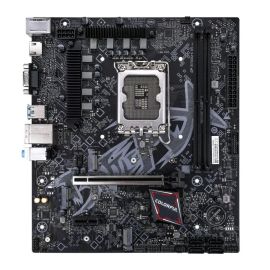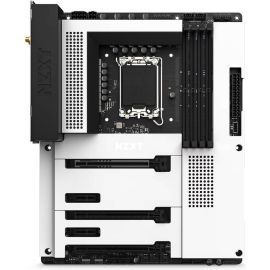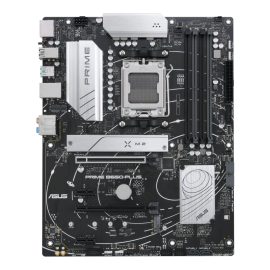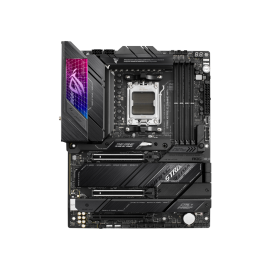Motherboards
Motherboards are the backbone of any PC assembly where they serve the role of hub through which the processor, memory, the graphics card, storage, and peripherals are connected to. Quality motherboard will improve the performance, stability, and durability of gaming PCs, content management systems, and workstations as well as productivity-level upgradable systems. The current generations of motherboards are targeting a global audience with the latest CPUs of Intel and AMD, both mainstream Intel Core i5, i7, i9 and AMD Ryzen 5, 7, 9, and workstation-class, such as Intel Xeon and AMD Threadripper. Regardless of whether you are building a small mini-ITX or a high performance full-tower gaming PC, it is important to pick the mother board to make sure of compatibility, upgrading options and performance.
The latest motherboards support an upgraded specification of PCIe 4.0, and PCIe 5.0, which will allow the quickest storage and graphics extensions. They possess several slots of M. 2 NVMe SSD drives, multi-channel DDR4 / DDR5 memory, high-speed USB files such as USB-C with USB 3.2 Gen 2 and Thunderbolt 4, and multi-GPU capabilities by using SLI and CrossFire in related chipsets. The power delivery, heatsink architecture, super PCIe reinforced PCIe slot count, and maximized BIOS functions should, meanwhile, last under a tight overclock or in heavy workloads.
Compatibility of CPU and Chipset
The motherboards differ according to the supported socket of CPU and chipset family. Currently, Intel platforms cover LGA 1700 with 12 th and 13 th Gen Core processors and new LGA 1851 with 14 th Gen; the best-known AMD platforms are AM4 (Ryzen 3000 and 5000 series) and AM5 (Ryzen 7000 series). All the platforms are customized.
Intel LGA 1700 motherboards also support either DDR4 or DDR5 memory, PCIe 5.0 x16 on some and built-in Wi-Fi 6E or 7.
The new AMD AM5 motherboards bring the PCIe 5.0, DDR5 support, and improved VRM design to allow more core count.
The budget Intel or AMD boards with the chipset such as H610, B660, or B650 have the necessary functionality, such as M.2 storage and USB ports.
Non-pro chipsets such as Z790 or X670E allow overclocking, multi-GPU SLI and CrossFire, Thunderbolt 4, 10Gb Ethernet, and also intelligent cooling zones.
The differences in the chipsets influence the distribution of PCIe lanes, memory channels, back-panel I/O and overclocking potential which means that it is necessary to select the motherboard that fits your choice of CPU and upgrade strategy.
Build Types and Form factors
Motherboards take the form of different form factors to suit the cases and constructions.
AtX is full-sized tower standard, and has the most PCIe and RAM slots.
Micro-ATX is smaller but still flexible and it works well in mid-tower spaces allowing multigp or expansion cards.
Mini-ITX is most suitable on small-form-factor build with no loss of some important aspects such as dual-channel memory and the availability of at least one M.2 port.
E-ATX or XL-ATX are "long" versions of ATX designed into high performance workstations or enthusiast gaming PCs with additional I/O and memory slots.
Decisions about form factors deal with case compatibility, case airflow design, and cable routing and general aesthetics of a build. Most constructors choose the mini-ITX boards in case they want small, or the ATX boards with a possibility to expand in the future.
Memory Support: DDR4 against DDR5
A decision between the DDR4 and DDR5 memory support is important.
The DDR4 motherboards are relatively low priced and provide great performance up to DDR4-3600 and even higher depending on the model.
The DDR5 motherboards offer faster bandwidth and control more power, and enhanced memory kits such as DDR5-6000 and surrounding. BIOS Memory tuning and XMP or EXPO profiles are enabled in the advanced BIOS of AM5 and LGA 1700 DDR5 motherboards.
Memory support affects performance in gaming, content creation and data intensive apps. DDR5 boards make systems future-proof, but DDR4 is still appealing in a price-conscious machine.
Growth and Interaction
Motherboards in the modern generation have plenty of connectivity capabilities to future proof systems.
PCIe Slots have x16 slots used with GPUs, PCIe 4.0 or 5.0 on newer boards and additional smaller x1 slots used by expansion cards.
Storage: Single or dual M.2 slots support M.2 PCIe storage up to PCIe 4.0 x4, and some boards support access to PCIe 5.0 storage.
Storage: 4-8 SATA III: There will always be legacy HDDs and SSDs in need of up to 8 SATA (or up to 8 storage ports in general, as non-SATA storage also exists).
USB ports: USB 3.2 Gen 2x2 and USB 3.2 Gen 2x1 to 3.2 Gen 1 USB 2.0 (through adapter). USB 3.2 Thunderbolt 4.
Networking: Two and a half gigahertz Ethernet is usual, and 10 gigahertz or two-LAN among the top-end; and Wi-Fi 6E or Wi-Fi 7 functionality is integrated.
Audio: On board audio models range between low level ALC887 to hi speck ALC4080 with various capacitors and isolated PCB segments to have clearer sound.
The compatibility is generalized in various regions; it allows the user to be flexible when it comes to connecting GPUs, storage, keyboards, mice, audio gear, VR headsets and capture cards to work with little to no problems.
Cooling Power Delivery
Quality transportation of power and thermal engineering is important to stability in performance.
Design: VRM Design: Premium boards will have 12+2 or 16+2 phases of VRM designs fitted with quality capacitors and choke. It should include overclocking functionality of CPU.
Heatsinks and Heatpipes: These are applied on VRMs, chipset areas, and M.2 slots so that more heat is dissipated during prolonged activities.
Cooling Headers united: Variable fan, AIO, and pump multiplex with adjustable fan curves to maximize the airflow in the case.
Passive v. vs Active: The mid-range boards would do fine with passive cooling, and top end-boards could feature chipset cooling fans or liquid potential (probably hidden) VRM heatsinks.
Effective thermal management promotes product long-term life and endurance in extreme video game playing, rendering, or bench marking.
BIOS, software and over clocking
In modern motherboards, tuning gets simplified by the means of high-featured BIOS and software.
UEFI BIOS, EZ-mode, fine tuning, secure boot features and extensive fan controls.
There are automatic CPU and memory overclocking profiles that saves time and reduce manual tuning.
There are Q-Flash Plus or Flash BIOS buttons to update the BIOS without CPU or RAM installed.
They are provided in the form of a software suite, which may have fan control dashboards, RGB lighting systems, network traffic prioritization, and monitoring.
These tools do not only assist the builders on the entry-level and advanced users with optimized and safe builds without the necessity of expertise but rather carry out error checking and code tampering.
Cases of application: Gaming, Content Creation and Innovation
Motherboards are designed to different applications.
Gaming Builds are optimized at multi-GPU, high-speed networking, displays with high refresh rates, and BIOS/DDR XMP-friendly support to play games.
Content Creation Workstations feature PCIe lanes that are optimized and optimized specifically to video capture, professional audio, quad-channel memory, and fast storage.
These Mini-ITX Builds offer the compact systems having a single x16, dual-channel RAM, and built-in Wi-Fi.
Silent or Aesthetic Systems are powered by fanless chipsets, beefy PCIe slots and RGB synchronisation to support uninhibited and noiseless systems.
The choice of a motherboard will rest on intended use, and it is usually done with a trade-off in the features such as VRM, connectivity, form factor along with expandability.
Tips on Buying and Build
Line up chipset and match that CPU socket to your processor of choice and your upgrading plans.
Select form factor depending on the size of the case and the expansion requirements in future.
Choose DDR4 or DDR5 depending on one of them and budget.
Have sufficient PCIe, M.2, SATA, and USB connection, to use storage, GPUs, and peripherals.
Seek out strong VRM and cooling when overclocking or using high-core-count CPU.
Choose networking-based connectivity in case of the need of a wired or wireless high speed.
Tweak the performance with BIOS tools or software applications to do with safety.
Long-term value is facilitated by future-proof features, including PCIe 5.0, Wi-Fi 7 and DDR5.
Community Response and Dependency
Motherboards that are easy to access BIOS, have steady power delivery systems, silent cooling systems, and reliable I / O system configurations are commonly praised by builders. Often popular models are commended on good VRM, good supportive communities and easy set up. Solder joint issues, BIOS bugs or VRM thermal problems are the kind of things you normally hear bugging people and then gets fixed by a motherboard firmware update and/or board revision which means that motherboards today are the most reliable they have ever been.
Newest Trends and New-Gen Platforms
Enhanced XMP or multistar EXPO-tuned DDR5 is gaining followers as it becomes cheaper and faster than DDR5-8000.
The new PCIe 5.0 is not restricted to GPUs as it is used in super-fast M.2 SSDs and AI accelerators.
Wi-Fi 7 boards are on the rise with data over 5.8 Gbps and transmit data with lower latency.
Mini-ITX form factor is still advancing with support of fullsize GPUs, 2 M.2 SSDs, and luxurious VRM designs.
Machine learning-based profiles and dynamic cooling scaling will be available soon in AI-enhanced BIOS providing performance tuning in the latter.
These advancements design the new desktop and workstation constructions with quicker workflow and intelligent energy consumption.
Final Word
Motherboards are the unseen conductors of any PC construction that tie together parts, allocate power, and allows communication to provide elite performance. Be it the next-generation gaming machine, a creator workstation, a mini-silent PC, the correct motherboard choice will provide the platform on which stability, upgradability and excellent functionality can be assured. The latest motherboards are available with current performance and future flexibility due to the changing technologies such as PCIe 5.0, DDR5, and AI-optimized BIOS.
High-Search Keywords Utility
motherboard motherboard LGA 1700 motherboard AM5 motherboard DDR5 motherboard PCIe motherboard compute motherboard motherboard with AMD AM5 motherboard motherboard with Wi-Fi 6E motherboard motherboard with Wi-Fi 7 overclocking motherboard motherboard motherboard USB-C motherboard motherboard with Thunderbolt 4 motherboard Z790 motherboard motherboard B650 motherboard X670E motherboard motherboard Intel motherboard motherboard AMD motherboard motherboard DDR5 motherboard high-quality motherboard motherboard form factor












![Colorful CVN B860I Gaming Frozen V20 Mini-ITX Motherboard (LGA1851, Intel B860, DDR5 up to 96GB, PCIe 5.0 x16, 2× M.2 [PCIe 5.0 + 4.0], Wi-Fi 6E AX211, 2.5GbE, USB-C 20Gbps) — CVN Frozen White](https://www.godukkan.com/media/catalog/product/cache/034d268ff8613a6d6d630062890130bf/5/8/colorful-cvn-b860i-gaming-frozen-v20-mini-itx-motherboard-lga1851-intel-b860-ddr5-up-to-96gb-pcie-50-x16-2-m2-pcie-50-40-wi-fi-6e-ax211-25gbe-usb-c-20gbps-cvn-frozen-white.jpg)
![Colorful CVN B860I Gaming Frozen V20 Mini-ITX Motherboard (LGA1851, Intel B860, DDR5 up to 96GB, PCIe 5.0 x16, 2× M.2 [PCIe 5.0 + 4.0], Wi-Fi 6E AX211, 2.5GbE, USB-C 20Gbps) — CVN Frozen White](https://www.godukkan.com/media/catalog/product/cache/c624bd7745bbc1545566bf67aea6a5de/5/8/colorful-cvn-b860i-gaming-frozen-v20-mini-itx-motherboard-lga1851-intel-b860-ddr5-up-to-96gb-pcie-50-x16-2-m2-pcie-50-40-wi-fi-6e-ax211-25gbe-usb-c-20gbps-cvn-frozen-white.jpg)










